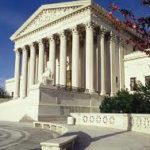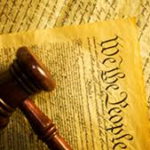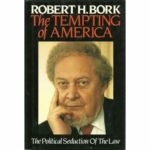Constitutional Conundrums: Part 1

What is the nature of our present dilemma, and how did we get here?
With President Trump’s appointment of Justice Brett Kavanaugh, and perhaps more to come, many observers anticipate a conservative majority on the Supreme Court for the first time in decades. What should a “conservative” Supreme Court do? This is a harder question than it seems.
Constitutional law is a difficult subject for conservatives. For one thing, there are a myriad of right-of-center perspectives on the Constitution. Differences begin with the threshold question whether the Supreme Court is authorized to overrule laws as unconstitutional—the doctrine of judicial review. Some conservative scholars, such as Christopher Wolfe, question the doctrine of judicial review, established by Marbury v. Madison in 1803 even though not explicitly mentioned in the Constitution. Others, such as Bruce Fein, writing in The American Conservative, deride this position as a display of “legal ignorance.”

While Alexander Hamilton defended judicial review in Federalist No. 78, the inexorable expansion of judicial power in the guise of “constitutional interpretation” has largely validated the Anti-Federalists’ prediction of mischief by the unaccountable federal courts (which did not even exist under the Articles of Confederation). Brutus was right. The judiciary has not turned out to be “the least dangerous branch,” as Hamilton promised.
Some conservatives regard Chief Justice John Marshall, the influential figure who led the Court for 34 years, as a visionary jurist, while others view him as a power-hungry Federalist who pushed a nationalist agenda. Some on the Right urge a model of “judicial restraint”—deferring to the political branches absent an express direction from the Constitution. Many libertarians, in contrast, advocate an expansive role for judges in the enforcement of “unenumerated rights,” a technique they style “judicial engagement.” Thus, depending on one’s perspective, political majorities are either tyrannical factions, or the voice of a self-governing polity.

Some conservatives believe passionately that courts must rely on “natural law” principles to divine the true meaning of the Constitution, while noted constitutionalists such as Antonin Scalia and Robert Bork—both condemned by Harry Jaffa as “positivists”–looked strictly to the text and history to discern the original meaning (a practice referred to as “originalism”). The Ninth Amendment is either an “ink blot” (in Bork’s famous formulation) or the font of endless judge-made rights. Ilan Wurman, a conservative defender of originalism, suggests that the Constitution, full of “compromises and philosophic inconsistencies,” may not be susceptible of a single theory of interpretation.

The Cato Institute’s Roger Pilon favors a broad interpretation of the 14th Amendment, on the grounds that it was intended “to reorder fundamentally the relationship between the federal and the state governments.” Pilon’s triumphant conclusion, that “the Civil War Amendments were meant to radically change the relationship between the federal government and the states,” is anathema to many conservatives.

Some on the Right contend that the only “solution” to the current state of constitutional “law”—decades of activist decisions purporting to derive from the Constitution—is to convene an Article V convention of the states and adopt numerous amendments overturning errant precedents. Others (including me) regard this strategy as “a fanciful, impractical, even Rube Goldberg-like-scheme” that could backfire, resulting in “an open-ended convention whose decisions made the problem worse.” And so on.
Conservatives are all over the map when it comes to constitutional interpretation, and spend as much time in internecine feuds as they do in battle with liberal activists. For example, center-right scholars still wrangle over the validity of “substantive due process,” invoked in Lochner v. New York (1905) to protect laissez-faire capitalism, even though the doctrine has been moribund for 80 years! Conservatives can’t even agree on whether the 14th Amendment required so-called “birthright citizenship” for the offspring of illegal aliens born in the U.S. As a result, discordant conservatives have been largely ineffective in articulating—let alone advancing—a coherent vision of constitutional law. The theme of “strict construction,” on which Richard Nixon successfully campaigned in 1968, is a slogan, not a self-executing judicial philosophy.
Even now, what passes as center-right constitutional scholarship in the legal academy—mainly consisting of libertarians rather than “traditional” conservatives—spurns Scalia and Bork as obsolete archetypes of “old” originalism, and instead pursues increasingly-esoteric theories of “new originalism,” which are as varied and open-ended as the non-interpretive theories Bork railed against in the 1970s and 1980s. Some aspects of “new originalism,” such as a preoccupation with reviving the “privileges or immunities” clause of the 14th Amendment, laid to rest in the Slaughter-House Cases (1873), would expand the potential for liberal activism. In contrast, the Left presses forward with a unified approach to the Constitution: unabashed activism on the part of unelected judges to invent “rights” found nowhere in the Constitution, overruling the political branches as necessary to implement policies favored by the legal academy. Not surprisingly, the Left has made consistent advances, while dithering conservatives often chase their tail. Nowhere is the rout more evident than in the law schools.

The legal academy has become the vanguard for progressive ideology in America—arguably the most thoroughly politicized (and left-leaning) discipline in higher education today. Law schools are the equivalent of the Politburo for the legal establishment: they define the mainstream of thought, which begins as fashion but quickly hardens into dogma. Scholars at elite law schools espouse a policy agenda greatly at odds with mainstream popular opinion, and contrary to the intentions of the Founders, yet amazingly consonant with the evolving jurisprudence of activist judges: abortion on demand, same-sex marriage (and LGBT rights generally), racial preferences for favored minorities, expansive powers for administrative agencies, weak protection for religious liberties and property rights, nearly-unlimited authority for Congress to regulate pursuant to the Commerce Clause, and so forth. Like their Progressive predecessor, Woodrow Wilson, constitutional law scholars on the Left believe the Constitution, as written, is defective and obsolete, and want to replace it with their values. With the eager cooperation of liberal judges, they have been remarkably successful.

The convergence of prevailing opinion in the legal academy and the direction of judicial decision-making is not merely a coincidence; alumni of elite law schools comprise the talent pool from which most federal appellate judges (and virtually all Supreme Court justices) are drawn. Elite opinion in legal circles is shockingly monolithic, bordering on robotic, and the prodigious scholarly output of the nation’s leading law schools (and their student-edited law reviews) is so uniform and well-synchronized that it resembles nothing so much as a dance routine by the Radio City Rockettes, the swimmers in an Esther Williams aqua-musical, or the Mormon Tabernacle Choir. The legal culture being slavishly prone to groupthink, the gravitational pull of the academy’s progressive creed—an orthodoxy that transcends mere consensus–exerts enormous influence over the judiciary. On the Court, Democrat-appointed justices, unlike their Republican counterparts, nearly always vote as a bloc.
Appellate judges, I have suggested, often serve as the academy’s ventriloquist dummies, with the progressive professoriate doing the real talking. Unlike persnickety conservatives, who fret ceaselessly over principle, or worry about their popularity, the Left is concerned only with wielding power to achieve desired results.
Harvard Law School professor Mark Tushnet, a prominent constitutional law scholar, summed up this approach in an 1981 article when he wrote that, if he were a judge, he would decide cases based on “which result is, in the circumstances now existing, likely to advance the cause of socialism.”[1] If that sounds like a radical statement coming from someone teaching constitutional law, consider that Justice Elena Kagan was Dean of the Harvard Law School when Professor Tushnet was hired at that august institution. Tushnet’s promotion of socialism as constitutional theory was hardly controversial, and certainly not disqualifying. In the Ivy League, edgy is “cool.” Tushnet, a self-described Marxist who clerked for Justice Thurgood Marshall, is—incredibly–in the mainstream of elite legal thought. (Harvard Law School is the alma mater of Chief Justice John Roberts and several of his colleagues; most of the rest attended Yale.)

Nor were Tushnet’s musings isolated. In 2016, when most on the Left blithely assumed that Hillary Clinton would be elected President, Tushnet wrote a highly-revealing blog post on the influential site Balkinization (named for the blog’s publisher, Yale Law School professor Jack Balkin), entitled “Abandoning Defensive Crouch Liberal Constitutionalism.” Tushnet’s premise was that Democrat-appointed justices would imminently take firm control of the Supreme Court (no more of that messy 5 to 4 see-saw business brokered by Justice Anthony Kennedy as the fickle swing vote), sparing liberal judges the need to worry about following precedent or getting reversed. Tushnet’s widely-publicized advice (or directive?) to the Court was remarkably candid: overrule unfavorable precedents at the first opportunity; take no prisoners in the culture war (which, he said, “they lost, we won”); aggressively manipulate legal rules “to empower our allies and weaken theirs”; use uber-activist justices such as William Brennan and Thurgood Marshall as role models; and ignore the doctrinal middle ground (Kennedy’s “swing vote” having become moot). In other words, put the pedal to the metal. Onward to victory!

As a cavalier afterthought, a cocky Tushnet added: “Of course all bets are off if Donald Trump becomes President. But if he does, constitutional doctrine is going to be the least of our worries.” This is how the Left thinks about constitutional law (which explains the Democrats’ meltdown over Brett Kavanaugh). Tushnet’s brazen comments, although more candid than most of his progressive colleagues, are typical of their overall orientation. Due to their unanimity, lack of scruples, and insatiable appetite for power, liberals have been remarkably successful in assuming control of the national government under the oxymoronic rubric of the “living Constitution”—judges simply making things up to produce desirable policy outcomes. Their success was enabled by first achieving hegemony in the academy.

To adapt Andrew Breitbart’s aphorism, judicial decisions are downstream from the mainstream of legal scholarship—the province of the law schools and the law reviews. As Robert Bork prophetically stated in 1982, “The ideas that win hegemony there will govern the profession, including judges, for at least a generation and perhaps more.” Appellate judges, including High Court justices, are reluctant to deviate from prevailing opinion in the law schools and other elite circles (such as Acela corridor pundits). Conversely, however, the robed oracles crave approval–and especially praise–from those same audiences, explaining the widely-acknowledged influence of left-leaning Linda Greenhouse, the former Supreme Court correspondent for the New York Times.

Where does this leave conservatives? Unfortunately, conservatives are greatly outnumbered by progressives in legal academia. Only a handful of law professors endorsed the Republican nominee prior to the 2016 presidential election. The Federalist Society works hard to magnify the shrinking influence of conservative thought in law schools, but that organization, once a platform for the likes of Bork and Lino Graglia (at the University of Texas), has widened its focus to include the growing libertarian perspective. As suggested earlier, conservatives and libertarians do not necessarily share a common vision of the Constitution—and sometimes sharply disagree. With the recent retirement of professors Stephen Presser (from Northwestern) and Lino Graglia, “traditional” conservatives teaching constitutional law no longer have a presence at America’s elite law schools. (I am excluding classical liberals, “new” originalists, and NeverTrumpers for present purposes.)

The Ivy League has become so insular and intolerant that any expression of support for bourgeois values by faculty in elite law schools will lead to censure, as University of Pennsylvania professor Amy Wax can attest. Conservative constitutional thought, now fallen out of fashion in the academy, is effectively in exile. Hence, ruminations such as mine occur elsewhere—in the pages of Misrule of Law. The struggle, however, is far from over. We have a canon: The Federalist Papers, Raoul Berger’s Government by Judiciary, Bork’s The Tempting of America, Presser’s Recapturing the Constitution, George Carey’s In Defense of the Constitution, Walter Berns’s Taking the Constitution Seriously, Philip Hamburger’s Is Administrative Law Unlawful?, and others. Although conservatives have lost ground in the legal academy, they still hold limited sway in other disciplines, such as history, political science, and government, where significant scholarship pertinent to constitutional law continues unabated. Ironically, these departments take the Constitution more seriously than law schools do.

Moreover, popular authors such as Mark Levin write best-sellers on constitutional issues (e.g., Men in Black) from a conservative point of view, as does historian Kevin Gutzman (e.g., Who Killed the Constitution?). Many non-academic bloggers, publications, and media figures remain in the fray, and a few courageous litigation organizations (e.g., Alliance Defending Freedom, First Liberty Institute, National Right to Work Legal Defense Foundation, Students for Fair Admissions), achieve key victories in the courts, including the Supreme Court. And, thanks to the election of President Trump in 2016, and a Republican-controlled Senate, many solid originalist judges (including two new justices, so far) are being appointed to the federal bench. Conservatives are on the brink of controlling the biggest prize of all: the Supreme Court.

Still, we must ask the question: In the field of constitutional law, what, exactly, are conservatives trying to conserve? There are several options. The public meaning of the Constitution at the time of its drafting and ratification? The essential institutions of a free society: faith, family, limited government, private property, and federalism? The jurisprudential status quo? The right of political majorities to pass laws governing themselves? Or possibly the stability, integrity, and perceived legitimacy of our institutions, especially the Supreme Court? The Court is especially fragile in this regard, by virtue of being an unelected committee of nine that derives its power solely from the respect it commands from a public that is willing to accept its decisions as plausible interpretations of our national charter. A Court widely perceived to be purely political eventually loses its mystique, and forfeits its legitimacy, like the man behind the curtain in The Wizard of Oz.

The precarious nature of the Court’s moral authority forms the basis of the doctrine of stare decisis—the notion that judicial decisions interpreting the Constitution enjoy the status of constitutional law, have precedential weight, and should not lightly be set aside. I will explore the issue of stare decisis in a subsequent essay, but wish to confine the present focus to the asymmetric nature of the conservative conception of constitutional law as contrasted with the Left’s cynical—and singular—pursuit of power and results.
Each one of the goals suggested above is separate and distinct from the others. Depending on the ends (or ideals) to be achieved, proponents will be motivated to act in different ways, and to move in different (even conflicting) directions. In order to be effective, conservatives must reach a consensus regarding the end result they seek. And before reaching that consensus, conservatives must soberly and frankly confront the state of constitutional law in 2019.
The harsh reality of constitutional law—the body of Supreme Court decisions ostensibly based on the Constitution—is that it has little connection to the document drafted in 1787 and ratified (by nine states) in 1788. Cases interpreting the 14th Amendment, ratified in 1868, are similarly off base. In many important respects, the government we live under in 2019 is not at all the government envisioned by the Framers. Grassroots conservatives rightly condemn Roe v. Wade, and complain about Obergefell (concocting a right to same-sex marriage) and the Court’s Establishment Clause cases, which often banish religious expression from the public square. The Founding Fathers would be shocked and dismayed by those decisions.

The conservative commentariat, such as it is, also criticizes the “administrative state” and the New Deal-era precedents that enable alphabet soup administrative agencies to usurp lawmaking and adjudication from the branches the Constitution entrusted with those functions—Congress and the judiciary, respectively. The unsuccessful challenges to the constitutionality of Obamacare united the factions of the Right in advocating limits to Congress’s Commerce Clause power. Here, conservatives and libertarians were—and remain–on the same page.
But the problem is far deeper than a few bad decisions in recent decades. Nor did the damage begin with the so-called Warren Court (named after Chief Justice Earl Warren) in the 1950s and 1960s. In truth, the Court went off the rails during the New Deal, in response to President Franklin D. Roosevelt’s threat to pack the Court, thereafter rubber-stamping FDR’s grandiose schemes to re-engineer the national economy. Unfortunately, the Court continued in that vein long after FDR’s death in 1945 because Roosevelt was able to appoint eight new Supreme Court justices during his 12 years in office, including former KKK member Hugo Black and left-wing wunderkind William O. Douglas, who at the age of 40 embarked on a record 36-year long tenure as the most reckless and doctrinaire activist ever to sit on the Court.
The New Deal court dramatically expanded the power of the federal government, concluding in Wickard v. Filburn (1942) that Congress’s authority to regulate “commerce among the several states” extended to regulating the amount a wheat a farmer could grow for his own consumption. At the same time, in Home Building & Loan Ass’n v. Blaisdell (1934), the Court eviscerated express constitutional protections for the obligation of contracts. FDR’s influence on the Court went far beyond economics. Black, a viciously anti-Catholic bigot, was responsible for authoring two misguided decisions that have thrown the Court’s First Amendment jurisprudence into disarray: Everson v. Board of Education (1947) (banning government aid to parochial schools) and Engel v. Vitale (1962) (banning prayer in public schools). In 1965, Douglas went on to author the notorious decision in Griswold v. Connecticut, recognizing an extra-constitutional “right of privacy” that eventually morphed into Roe v. Wade and Obergefell, based on the flimsiest of grounds: “penumbras, formed by emanations” from the Bill of Rights.
Under the Warren Court, the phrases “due process” and “equal protection” from the 14th Amendment became a playground for judicial activism, including the wholesale “incorporation” of the Bill of Rights (originally applicable only to the federal government) against the states. Some legal historians trace the origins of the current reign of judicial activism to the early days of the republic, when Justice Samuel Chase, an ardent Federalist, urged a broad interpretation of constitutional text in Calder v. Bull (1798). Chase would later be the only Supreme Court justice to be impeached for his arbitrary conduct as a judge, but the Senate failed to convict him. Chase’s unsuccessful impeachment has been regarded as an unofficial precedent that federal judges cannot be removed from office based solely on their rulings, no matter how unfounded in law. Thus, unelected, life-tenured judges are utterly unconstrained, and behave accordingly.

John Marshall, the celebrated author of Marbury v. Madison (1803) also penned controversial opinions in McCulloch v. Maryland (1819), Gibbons v. Ogden (1824), and other cases that paved the way for an expansive, “nationalist” reading of the powers of the federal government over the states. These decisions do not generally receive the same attention as the landmark ruling in Marbury v. Madison, but arguably subverted the original meaning of the Constitution long before Reconstruction. The most momentous Supreme Court decision of all, Brown v. Board of Education (1954), made the Court the nation’s moral arbiter. Based on an ahistorical interpretation of a vague phrase in the 14th Amendment, “equal protection of the laws,” in one judicial stroke the Court ended all state-sanctioned segregation.
As I explained a few years ago in National Review,
Brown is canonized now, and the result — which was politically inevitable — is unassailable, but the reasoning of the decision was controversial in its day, provoking Columbia Law School professor Herbert Wechsler to write a cautionary (and frequently cited, albeit largely disregarded) article in the Harvard Law Review entitled “Toward Neutral Principles of Constitutional Law” (1959). That was then. Driven by a half-century of expansive constitutional-law scholarship in the academy, the mainstream no longer recognizes such misgivings, and anyone today expressing doubt over the wisdom or legitimacy of Brown would be treated as a heretic. In 2015, Wechsler would probably be unable to get his article published, and such unfashionable opinions would keep a young academic from gaining tenure (or Senate confirmation).
Wechsler, no conservative, was not alone in expressing doubt regarding the constitutional justification for Brown. Bork’s liberal colleague at Yale Law School, Alexander Bickel, shared Wechsler’s concern, as did the respected jurist Learned Hand. Hand’s criticisms of Brown, delivered in the 1958 Holmes Lectures at Harvard Law School, were reprinted in a best-selling book, The Bill of Rights. The tide has turned. The Left, now recognizing the moral authority Brown confers on activist decisions, uses it to discredit originalism, implicitly acknowledging that Brown was an act of judicial usurpation, and daring conservatives to criticize Brown as incorrectly decided. Wishing to preserve their reputations and careers, no one takes the bait. Even Bork managed to articulate an “originalist” defense of Brown, even though the 39th Congress, the drafters of the 14th Amendment, oversaw segregated schools in the District of Columbia.
Brown has become sacred. Liberal justices on the Court have forever been emboldened by the knowledge that even a groundless interpretation of the Constitution will be greeted with approval if the “right” audience agrees with the result. To the Left, Brown serves to validate the legitimacy of the “living Constitution.”
If this capsule summary of constitutional decision-making leaves the reader feeling that the Court has long served as an ersatz super-legislature, at least on certain contentious political issues, that conclusion is not altogether misplaced. Segregation, abortion rights, affirmative action, equal rights for women, sexual harassment, gay rights, same-sex marriage—all these hot button questions were “resolved” in whole or in large part by the Court, often without compelling textual support in the Constitution or applicable law. Don’t misunderstand me: In many other cases, the Court interprets the law correctly (or at least reasonably), applying the relevant text or following sound precedent. In key cases, however, the Court reaches expedient decisions based on its subjective assessment of what “is best for the country,” leavened with consideration of what it can get away with, ruling by a combination of brazen usurpation and supine abdication, with the result sometimes determined in weather vane fashion—depending on the prevailing direction of the political winds. This is the unfortunate legacy of Brown.
Over the course of the Court’s history, this type of judicial lawmaking—outright legislating from the bench–has been employed in different ideological directions (the Lochner era being an example of pro-business activism), but during the past 80 years or so the Court has steadily tacked to the Left.
Just as legal scholars on the Left play an essential role for liberal judicial activists—by skewing the doctrinal landscape and providing intellectual cover for their lawmaking—the right-of-center professoriate serves as the countervailing voice, defending the true Constitution. At least in theory. As we have seen, however, there is often confusion (or at least disagreement) on the Right about what the Constitution means—how it should be interpreted. The larger problem, similar to the so-called Stockholm Syndrome—the psychological phenomenon of hostages identifying with their captors—is that many conservative legal scholars, overwhelmed in numbers by progressive and libertarian colleagues, become cowed. Their attitudes bend to conform to the surrounding intellectual milieu. With the passing of Bork, traditional conservatives lost their full-throated voice of resistance.

Eschewing “controversial” positions at odds with prevailing sentiment in the academy—such as opposition to same-sex marriage–conservatives are lured to compromise. For example, one of the founders of the Federalist Society, Northwestern University law professor Steven Calabresi, who clerked for both Robert Bork and Antonin Scalia, has purported to divine an “originalist” defense of Obergefell. This is the “new” originalism at work. Calabresi’s mentor, Bork, would scoff at such fatuous sophistry. Virtually no one in the legal academy today criticizes Brown. It, too, is justified on “originalist” grounds. If the “new” originalism is so malleable that it can be pounded into the shape of any desired result, it is not a useful guide for constitutional decision-making. “Our” side in the legal academy has lost its way.
Mollie Hemingway, writing in the Washington Examiner, recently explained what it means to be conservative in the Age of Trump. Her comments are salient here:
For too long, the conservative movement in Washington, D.C., functioned as the systemic opposition to progressivism’s march through American institutions, public and private. Technically, they were opposed, and they’d make some sounds about opposing the growth of the administrative state and the cultural rot. But they were never terribly successful at returning the country to its first principles or constitutional order, despite the millions of supporters who put them in power and expected not just rhetoric but results.
Conservatism now is about rejecting this rigged system and taking the risk of working outside of it to advance its principles and policy objectives. The fact that conservatism had become a checklist of watered-down progressive policy prescriptions only served to hasten the demise of the old system….Conservatism today is properly understood as constitutionalism and a revisiting of first principles about securing the blessings of liberty….And it doesn’t care one whit if it has to completely upset the existing political order.

Similarly, constitutional conservatives in the Age of Trump must rise up from the “defensive crouch” they have been in for decades and boldly confront the reality they face: With an ailing Justice Ruth Bader Ginsburg soon to depart the Court, and the 80-year old Stephen Breyer possibly next to follow, President Trump may be in a position to realign the Court in a conservative direction—for decades to come.

In an upcoming essay I will address what that means. Stay tuned.
[1] Tushnet, “The Dilemmas of Liberal Constitutionalism,” 42 Ohio State L.J. 411, 424 (1981).
Thank you, How Appealing! And Real Clear Policy (here)!
































